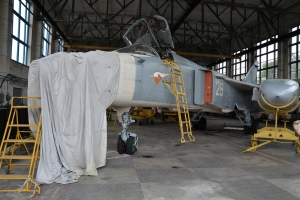Starokostiantyniv air base in western Ukraine is home to the Ukrainian Air Force’s 7th Bomber Aviation Regiment, flying the Sukhoi Su-24 Fencer. As a follow up to his recent article looking at the Ukrainian air defence assets based at Belbek air base in Global Aviation Magazine Issue 19, Nick Cross once again guest reports for GAR as he explores the unit’s history and the role it plays in the present day Air Force.
The 7th Bomber Aviation Regiment was formed in 1951 at Starokostiantyniv air base as one of the units of the 32nd Bomber Aviation Division, 24th Air Army of the Soviet Air Force, and was equipped with Ilyushin Il-28 bombers.

© Nick Cross
In 1966, a reorganisation took place led by the Commander, Colonel Olexiy V Bobkov and Chief of Staff, Major General Vasyl F Kalugin. In the late 1960s, the Regiment took part in Soviet exercises “Dunay” and “Vostok”. Sometime later it re-equipped with Yakovlev Yak-28s before, in 1977, the Sukhoi Su-24s arrived and these remain active today.
In the intervening years, the Regiment joined the 56th Bomber Aviation Division and in 2000 was incorporated in the 35th Aviation Group, later joining the 5th Aviation Corps of the Ukrainian Air Force.

© Nick Cross
For a period of time, there was a regiment of MiG-29s based alongside the Fencers, but these moved on to Ivano-Frankivsk, some 200km to the south-west.
In 2004, the separate Aviation Squadron was formed at Starokostiantyniv air base, and subsequently in October 2005 the Aviation Brigade was established.

© Nick Cross
In 2005, the Aviation Brigade (according to the decree of the President of Ukraine on transition of the Ukrainian Armed Forces to manning on a contract basis) was the first to carry out an experiment whereby the whole unit would be made up of non-conscripted personnel. This was successfully completed in 2006. That experience was shared with all aviation units of the Ukrainian Air Force.
In March 2008, the Aviation Brigade was renamed as the Brigade of Tactical Aviation. By decree of the President of Ukraine on 28 March 2008 (No. 281/2008) for high performance in combat training and progress in training, the Aviation Brigade was given the honorary name of Petro Franko (so named after the founder of the Ukrainian Air Force).

© Nick Cross
Later the Brigade was named Starokostiantyniv Brigade of Tactical Aviation, according to the Order of the Minister of Defence of Ukraine on 21 August 2008 (No. 411).
For three years, the Brigade has been ranked first among aviation units of the Ukrainian Air Force for high performance in combat training, and was awarded the pennant of the Ukrainian Air Force.

© Nick Cross
The Commander of the unit is Colonel Serhiy Blyzniuk (pilot of the first class). His total flight hours are approximately 1,500 and he has worked his way up the military ladder serving as pilot, senior pilot, commander, Deputy commander of Aviation Squadron, Deputy commander of the Regiment, Regiment commander and Deputy commander of the Brigade in flying training. He has participated in large-scale command exercises, and for meritorious service has been repeatedly given state awards.
The base, which lies just two miles east of the town of the same name, and the headquarters within the town itself, collectively cover an impressive area of roughly 25 square kilometres. Starokostiantyniv has a single runway in excess of 8,202ft, a large number of revetments, shelters and a couple of hangars. One is used as the base maintenance hangar and can accommodate two Su-24s at any time. Six- and 12-monthly maintenance is carried out on base and this is scheduled to take two weeks. More in-depth work is carried out at the aircraft repair plant at nearby Lutsk. The shelters were built for MiG-29s and as the Fencers do not fit, these are no longer in use.

© Nick Cross
Two variants are flown, the M and MR; the bombers are capable of carrying 8,000 kgs (17,600 lbs) of bombs, including various nuclear weapons (until 1994, there were nuclear weapons stored on the base but they were removed in accordance with the various non-proliferation treaties) and two or four R-60 (AA-8 “Aphid”) infrared missiles are usually carried for self-defence. The reconnaissance version just has the missiles as armament. The Su-24M also has a fixed armament of one GSh-6-23 cannon (with 500 rounds of ammunition) mounted in the fuselage underside.
Over 200 Su-24s were inherited when the Soviet Union collapsed and over 50 of these reside on base. Some are placed on reserve and can be returned to service if required with the rest being airworthy.

© Nick Cross
Student pilots spend 180 hours flying the L-39s at the flying school in Chuhuiv, near Kharkiv, before completing their transition to the Su-24 at Starokostiantyniv. Some pilots have been sent to Columbus AFB, Mississippi, to take part in the under-graduate flying training programme held there.
The base has flying activity two or three days a week which can be increased if required.

© Nick Cross
A couple of months ago, two L-39s arrived to be based at Starokostiantyniv and it is hoped that in future, there will be four present to be used for pilot training. Both aircraft are painted in the new digital camouflage, but there are no plans to paint the Su-24s the same way.
Nick Cross would like to thank Deputy Base Commander Colonel Micola Kovalenco, Captain Fedor Baryshok, Senior Lieutenant Vitalii Saliuk and Colonel (Ret) Petro Maidaniuk for their invaluable help and assistance with this article.























